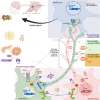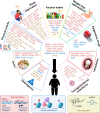Genetics and epigenetics in the obesity phenotyping scenario
- PMID: 37032403
- PMCID: PMC10088729
- DOI: 10.1007/s11154-023-09804-6
Genetics and epigenetics in the obesity phenotyping scenario
Abstract
Obesity is a common complex trait that elevates the risk for various diseases, including type 2 diabetes and cardiovascular disease. A combination of environmental and genetic factors influences the pathogenesis of obesity. Advances in genomic technologies have driven the identification of multiple genetic loci associated with this disease, ranging from studying severe onset cases to investigating common multifactorial polygenic forms. Additionally, findings from epigenetic analyses of modifications to the genome that do not involve changes to the underlying DNA sequence have emerged as key signatures in the development of obesity. Such modifications can mediate the effects of environmental factors, including diet and lifestyle, on gene expression and clinical presentation. This review outlines what is known about the genetic and epigenetic contributors to obesity susceptibility, along with the albeit limited therapeutic options currently available. Furthermore, we delineate the potential mechanisms of actions through which epigenetic changes can mediate environmental influences and the related opportunities they present for future interventions in the management of obesity.
Keywords: Epigenetics; GWAS; Genetics; Genomics; Monogenic; Obesity; Polygenic.
© 2023. The Author(s), under exclusive licence to Springer Science+Business Media, LLC, part of Springer Nature.
Conflict of interest statement
The authors declare no competing interests that are relevant to the content of this review article.
Figures



References
-
- National Health and Nutrition Examination. 2021. National Health and Nutrition Examination Survey 2017–March 2020 Prepandemic Data Files Development of Files and Prevalence Estimates for Selected Health Outcomes. - DOI
Publication types
MeSH terms
Grants and funding
LinkOut - more resources
Full Text Sources

